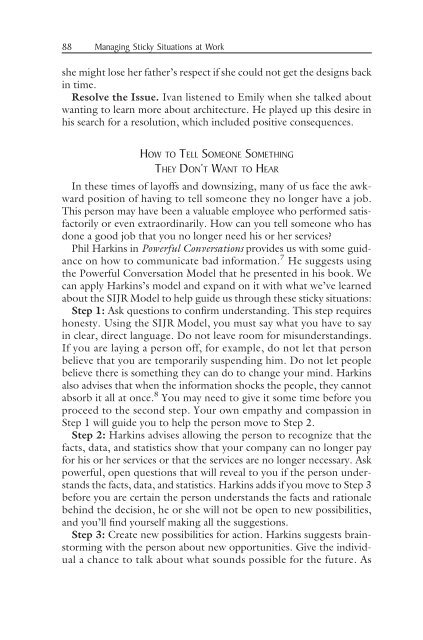Managing Sticky Situations at Work
Managing Sticky Situations at Work
Managing Sticky Situations at Work
Create successful ePaper yourself
Turn your PDF publications into a flip-book with our unique Google optimized e-Paper software.
88 <strong>Managing</strong> <strong>Sticky</strong> <strong>Situ<strong>at</strong>ions</strong> <strong>at</strong> <strong>Work</strong>she might lose her f<strong>at</strong>her’s respect if she could not get the designs backin time.Resolve the Issue. Ivan listened to Emily when she talked aboutwanting to learn more about architecture. He played up this desire inhis search for a resolution, which included positive consequences.HOW TO TELL SOMEONE SOMETHINGTHEY DON’T WANT TO HEARIn these times of layoffs and downsizing, many of us face the awkwardposition of having to tell someone they no longer have a job.This person may have been a valuable employee who performed s<strong>at</strong>isfactorilyor even extraordinarily. How can you tell someone who hasdone a good job th<strong>at</strong> you no longer need his or her services?Phil Harkins in Powerful Convers<strong>at</strong>ions provides us with some guidanceon how to communic<strong>at</strong>e bad inform<strong>at</strong>ion. 7 He suggests usingthe Powerful Convers<strong>at</strong>ion Model th<strong>at</strong> he presented in his book. Wecan apply Harkins’s model and expand on it with wh<strong>at</strong> we’ve learnedabout the SIJR Model to help guide us through these sticky situ<strong>at</strong>ions:Step 1: Ask questions to confirm understanding. This step requireshonesty. Using the SIJR Model, you must say wh<strong>at</strong> you have to sayin clear, direct language. Do not leave room for misunderstandings.If you are laying a person off, for example, do not let th<strong>at</strong> personbelieve th<strong>at</strong> you are temporarily suspending him. Do not let peoplebelieve there is something they can do to change your mind. Harkinsalso advises th<strong>at</strong> when the inform<strong>at</strong>ion shocks the people, they cannotabsorb it all <strong>at</strong> once. 8 You may need to give it some time before youproceed to the second step. Your own emp<strong>at</strong>hy and compassion inStep 1 will guide you to help the person move to Step 2.Step 2: Harkins advises allowing the person to recognize th<strong>at</strong> thefacts, d<strong>at</strong>a, and st<strong>at</strong>istics show th<strong>at</strong> your company can no longer payfor his or her services or th<strong>at</strong> the services are no longer necessary. Askpowerful, open questions th<strong>at</strong> will reveal to you if the person understandsthe facts, d<strong>at</strong>a, and st<strong>at</strong>istics. Harkins adds if you move to Step 3before you are certain the person understands the facts and r<strong>at</strong>ionalebehind the decision, he or she will not be open to new possibilities,and you’ll find yourself making all the suggestions.Step 3: Cre<strong>at</strong>e new possibilities for action. Harkins suggests brainstormingwith the person about new opportunities. Give the individuala chance to talk about wh<strong>at</strong> sounds possible for the future. As















